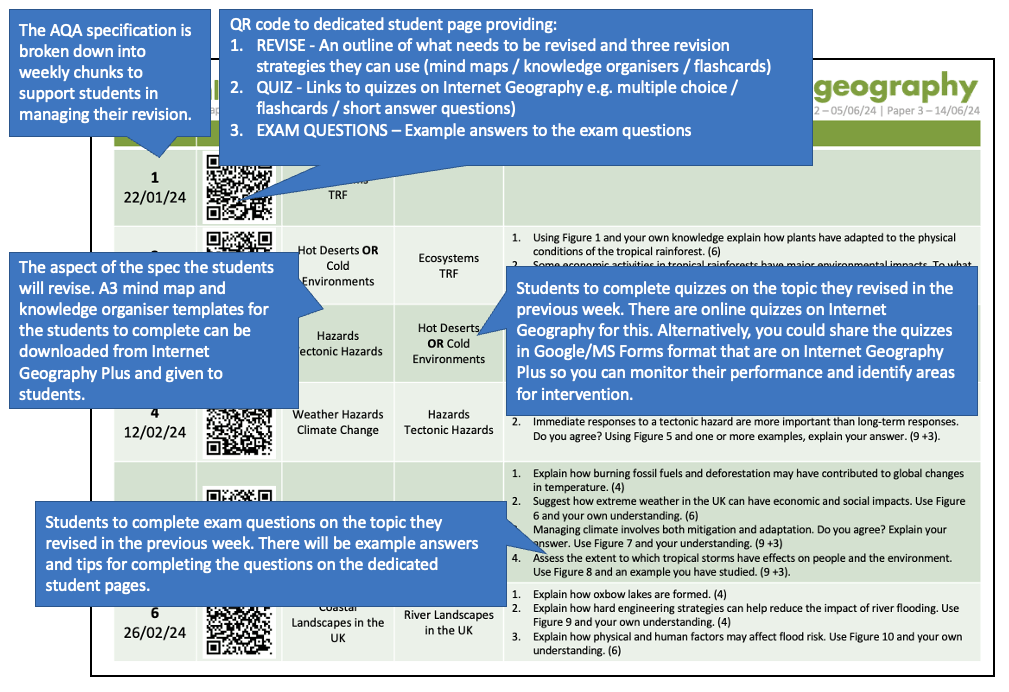Britain’s Most Desirable Towns
Britain’s most desirable towns, according to The Telegraph.
Revision Resources on Internet Geography Plus
Revision Resources on Internet Geography Plus
As we head into revision season, we wanted to share a selection of our resources to support you and your students in preparing for the 2024 AQA GCSE exams.
There’s a huge range of revision resources on Internet Geography Plus, so we’ve pulled together a collection of some of our favourites to help give you an overview of the resources on Plus that will save you time and help your students prepare for their exams.
If you have any specific requests, let us know!
Subject Knowledge
The Final Countdown
The Final Countdown is a comprehensive weekly approach to revision that involves students revisiting content, checking knowledge and understanding through quizzes, and allowing students to attempt a range of exam questions with model answers. We’ve made a few updates this year, and you can download the student and teacher resources from here: https://www.internetgeography.net/internet-geography-plus/the-final-countdown/
Revision Boost Booklets
Our Revision Boost Booklets are an ideal way to support students revisiting content. Each booklet contains QR codes to pages on InternetGeography to support students in covering the content for Papers 1 and 2.
Log in and head over to https://www.internetgeography.net/internet-geography-plus/revision-boost-booklets/ to download!
Revision Quizzes
We have an extensive collection of multiple-choice quizzes available in the booklet and Google/MS Forms format. The Google/MS Forms can be copied to your drive in one click and are self-marking to save you time!
Google/MS Forms Quizzes: https://www.internetgeography.net/internet-geography-plus/geography-online-quiz-forms/
Multiple-choice booklets: https://www.internetgeography.net/internet-geography-plus/multiple-choice-knowledge-checker/
Revision Mats
Retrieval questions with model answers: https://www.internetgeography.net/geography-revision-mats/
Find and Fix
A great way to check subject knowledge, Find and Fix involves students finding errors and then fixing them. Download from here: https://www.internetgeography.net/internet-geography-plus/find-and-fix/
Geogrevise
Booklets containing retrieval questions, with example answers provided: https://www.internetgeography.net/subscribe/geogrevise/
Knowledge Organisers
A comprehensive collection of knowledge organisers covering content from across the specification: https://www.internetgeography.net/internet-geography-plus/geography-knowledge-organisers/
Odd One Out
Students identify the odd one out: https://www.internetgeography.net/internet-geography-plus/odd-one-out/
Infographics
A huge collection of infographics summarising a range of areas of the specification and case studies: https://www.internetgeography.net/internet-geography-plus/infographics/
Recap Sheets
There are 88 recap sheets containing retrieval activities to revisit areas of the specification: https://www.internetgeography.net/internet-geography-plus/recap/
Case Study Summaries
Summary sheet to support students structuring revision notes:https://www.internetgeography.net/internet-geography-plus/case-study-summaries/
Exam Technique
Mock exam papers and mark schemes
A collection of mock exam questions and full papers (inc. mark schemes) can be downloaded here: https://www.internetgeography.net/internet-geography-plus/aqa-gcse-geography-plus-resources/
Beyond the Resource
Resources to support students answering a question that involves a figure: https://www.internetgeography.net/internet-geography-plus/exam-skills-plus/
Rewrite it
Students review answers to exam questions, plan their answers, and then have a go at the question: https://www.internetgeography.net/internet-geography-plus/re-write-it/
PEEL templates for 6-9 mark questions
Templates covering a range of 6-9 mark questions across the specification: https://www.internetgeography.net/download/37859/?tmstv=1668616844
Apply your knowledge grids
Resources to support students in applying their knowledge to exam questions. These resources support students in going further than regurgitating facts and actually applying their knowledge to exam questions: https://www.internetgeography.net/internet-geography-plus/apply-your-knowledge-grids/
Geographical Skills
Which was the photographer facing? https://www.internetgeography.net/download/34021/?tmstv=1684232115
How to – statistical skills: https://www.internetgeography.net/download/33624/
How to – graphical skills: https://www.internetgeography.net/download/33739/
Geographical Skills multiple choice booklets: https://www.internetgeography.net/geographical-skills-multiple-choice-booklets/
Interpreting OS Maps booklets
Booklets to support students interpreting OS maps in the context of coastal and river landscapes: https://www.internetgeography.net/internet-geography-plus/interpreting-os-maps/
What is The Final Countdown?
The Final Countdown is a comprehensive set of resources to support students in the run-up to exams. The work of JB GeogTeacher inspired the initiative.
The Final Countdown has been created to provide students with weekly revision activities in the run-up to the AQA GCSE Geography exams in May and June 2023. Each set contains a six-week revision plan to support students in organising their revision. In addition, each week has a QR code to online resources, guides, quizzes and exam questions (including example answers and mark schemes) for students to use to prepare for their final exams.
The image below illustrates how The Final Coundown works.
Internet Geography Plus subscribers can access the six-weekly revision sheets now.
Each week, revision is divided into three sections: revise, quiz and exam questions.
Revise
Students revise an area of the specification, and the QR code will take them to a menu of pages on Internet Geography to support this. In addition, we’ve provided A3 templates for the students to use to structure their revision. These include knowledge organisers and mind maps. The image below shows examples.
Internet Geography Plus subscribers can download all knowledge organisers, and mind maps from The Final Countdown page on Internet Geography Plus.
Review
Review allows students to revisit their learning by completing online multiple-choice quizzes to test their knowledge. These are all available on Internet Geography for free. Alternatively, Plus subscribers could direct their students to the Internet Geography Plus MS/Google Forms quizzes to monitor progress (and completion!).
Exam Questions
Finally, students complete exam questions based on the area they revised the previous week. To support students, examples of answers to each question are published on each revision page. You can see a sample here.
Internet Geography Plus subscribers can access the resources here. However, if you’re not a subscriber, why not join to access this and over one thousand other resources? Please take a look at our subscription options.
If you have any questions, drop us an email.



